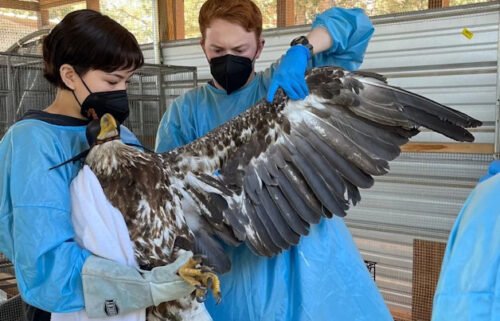Invasive aquatic rodent known as nutria spotted in Sacramento County. Here’s what to know
By TORI APODACA
Click here for updates on this story
SACRAMENTO, California (KOVR) — The invasive rodents known as nutria, spurred by California’s wet winter, have been spotted on Sherman Island in Sacramento County.
California Fish and Wildlife was first on alert about these rodents when they were spotted in the Central Valley in 2017. Now, the critters some people call swamp rats are spreading to other counties.
“An invasion of swamp rats in California, let’s be serious?” said Congressman Josh Harder from the 9th Congressional District. “But this is actually a real problem.”
The invasive South American aquatic rodent is distinguishable by its orange teeth, white whiskers and it’s ability to grow up to 40 pounds.
“The threat to crops, while there, is really secondary to the threat of the infrastructure,” said Executive Director of the San Joaquin County Farm Bureau Andrew Genasci.
The critters are known to burrow in levees, making flooding to agriculture and communities the biggest fear.
“They’re really taking millions of dollars’ worth of flood control and turning it into Swiss cheese,” said Genasci.
The solution? Eradicate the swamp rat.
“You try to find a big dent,” said Harder. “Once you find one swamp rat, you know there are a lot of others nearby.”
Since 2020, Fish and Wildlife’s full-scale operations have caused a downward trend of nutria, but it said the historic wet winter and flooding transported nutria downstream into the Delta.
“They will move anywhere where there is water,” said Genasci. “Anything connected to the Delta, they will follow those waterways.”
This is the amount of nutria that Fish and Wildlife has taken in California per county, updated on June 12, 2023:
Merced: 2,102 Stanislaus: 970 Fresno: 304 San Joaquin: 110 Sacramento: 16 Mariposa: 12 Solano: 2 Madera: 1
Total: 3,517
The rodents have made the move to new spots like Sacramento County. All 16 have been detected at Sherman Island.
“If we do not actually get this population under control, it could cost us hundreds of millions of dollars of infrastructure damage and losses to farmland,” said Harder.
The challenge is catching these aquatic rats before they reproduce. Starting in May 2023, Fish and Wildlife used specially-trained dogs to sniff out the nutria to capture the critters.
It conducted its first nutria detector dog field trials throughout the project area. These trials utilized seasoned handler/dog teams from the Chesapeake Bay Nutria Eradication Project to evaluate the tool in California and prepare for any modifications necessary to implement as a long-term technique in California.
Fish and Wildlife said, during the field trial, the dogs located an additional area of nutria sign and scat on Sherman Island. Following detections, teams were able to trap and remove three nutrias.
“The utilization of nutria detector dogs will be an increasingly valuable tool as nutria densities decrease and the remaining animals become increasingly difficult to detect, as well as in areas where cameras cannot be deployed (e.g., theft),” said Fish and Wildlife in a statement.
“One female can have 200 offspring a year,” Harder said.
Harder said $12 million from the state and federal government was approved in 2020 to help eradicate nutria. He said this amount has now been cut by 60%.
Please note: This content carries a strict local market embargo. If you share the same market as the contributor of this article, you may not use it on any platform.



